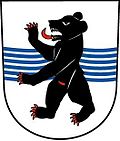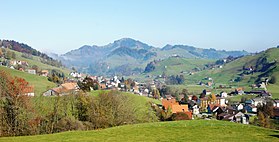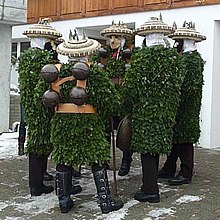Urnaesch
| Urnaesch | |
|---|---|
| State : |
|
| Canton : |
|
| District : | former Hinterland district |
| BFS no. : | 3006 |
| Postal code : | 9107 |
| Coordinates : | 739 412 / 242326 |
| Height : | 832 m above sea level M. |
| Height range : | 722–1588 m above sea level M. |
| Area : | 48.16 km² |
| Residents: | 2303 (December 31, 2018) |
| Population density : | 48 inhabitants per km² |
| Website: | www.urnaesch.ch |
|
Urnaesch |
|
| Location of the municipality | |
Urnäsch is the largest municipality in terms of area in the Swiss canton of Appenzell Ausserrhoden .
geography
Urnäsch is located south of Waldstatt on the river of the same name and on the railway line that connects Herisau with Appenzell . This is where the pass road begins across Schwägalp to Neu St. Johann . The lowest point is Murbach at 722 m above sea level. M. , the highest Petersalp with 1590 m above sea level. M. The most famous mountain in the municipality is the alp .
Neighboring communities are Waldstatt , Hundwil , Nesslau , Hemberg , Schönengrund and Schwellbrunn in a clockwise direction .
history

In 831 the hamlet of Färchen was mentioned as Farrichun and its river Urnasca. Under the abbot's rule, Urnäsch first formed an administrative district with Herisau, in the 14th century it was a Rhode of the Hundwil District and belonged with this to the Bailiwick of St. Gallen within the Reich Association. Urnäschenes showed its communal life of its own as early as 1344, and the Lendlyn joined the Swabian Association of Cities in 1377, and in 1401 the association with the city of St. Gallen. This happened under the Hundwils seal, with which it was a driving force in the Appenzell Wars from 1401 to 1429. For the time being, Urnäsch was church-owned after Herisau, after the construction of the Antoniuskirche in 1414 the Urnäschers achieved final ecclesiastical and political independence in 1417. A village center developed around the church within the scattered settlement. In 1525 the place went over to the Reformation, from 1532 to 1543 the Hundwil pastor Walter Klarer was Protestant pastor in the village. The church was rebuilt after the village fire of 1641 and renovated from 1866 to 1868. The Catholic parish of Urnäsch-Hundwil-Waldstatt with the church in the hamlet of Zürchersmühle was founded in 1911.
In 1480 Urnäsch and Hundwil cleaned up the border line after the shared Alps separated. Since the division of the land in 1597, Urnäsch has been the first of the six outer Rhodes to belong to the Land of Appenzell Ausserrhoden and has been a regular meeting place for the Small Council. The valley and village parts of the municipality expanded along the Waldstatt-Schwägalp route from the 18th century and gradually grew together. The largest municipality in Ausserrhoden also included Schönengrund until the early 18th century, which separated from 1720 to 1722. Urnäsch's population has fluctuated over the past centuries, mainly due to climatic and economic reasons: in 1667 it had 1,772 inhabitants, 1794 2,798, 1818 1,917, 1850 2,464, 1900 3,087, 1950 2,579 and in 2000 2,336 inhabitants; the trend is slightly decreasing.
Economy and tourism
Alpine farming with cattle and forestry have always played a prominent role. Until around 1900, wood and charcoal exports were important. Despite protective regulations for the community forests - first enacted in 1533 - deforestation increased massively from 1820, first for the charcoal burning and later also for the paper industry. In 1826 nine sawmills were counted. In 1901, the cantonal government declared the remaining forests to be protective forests.
There was a powder mill in the 17th century, a brickworks from 1801 to 1867 and a saltpeter mill until the early 19th century. The fair, held from 1592 on, was supplemented by two more from 1726. The manufacture of canvas is documented as early as 1515, the cultivation of flax in 1604. The weaving mill employed 672 weavers in 1826, and embroidery shaped the community in the 19th century. Several factories were built during this period.
The Elektrizitätswerk Urnäsch (EWU AG) has been supplying the municipality of Urnäsch with electricity since 1903 with the weir, storage pond and Rossfall plant. One third of the current consumption (2018) is produced as renewable energy by the five small power plants located on communal soil.
The interwar crisis hit the home industry, while factories often diversified more successfully. The textile industry remained the most important branch of business even after 1945; it only experienced a partial collapse in the 1980s. A carpet factory started operations in 1965, a spinning mill in 1978. Urnäsch has had a station on the Herisau-Appenzell railway line since 1875.
From 1850 the importance of tourism increased, with the village benefiting from its location as a starting point for excursions to Schwägalp and Säntis. The Säntis suspension railway was built in 1935, the ski lift and ski jump in 1944. In 2008 a Reka holiday village opened with around 300 beds. Many residents work in the Herisau-Gossau-St. Gallen, 957 jobs were still offered in the community. The most important sectors were the textile industry, book printing, dairy and livestock farming, handicrafts and small businesses. The Appenzell Museum of Customs opened its doors in 1976. In 2009 a cheese dairy was opened as the first regional development project in Switzerland.
population
Population development in Urnäsch
|
Religions / denominations in Urnäsch (in percent) - 2013  |
|||||||||||||||||||||||||||||||||||||||||||||||||||||||||||||||||||
Village renewal
In 2008, Urnäsch was a candidate for the European Village Renewal Award 2008 at the European ARGE Rural Development and Village Renewal. Together with four other municipalities, the jury placed Urnäsch in pride of place behind the winning village of Sand in Taufers in South Tyrol. The jury particularly praised the Reka holiday village, "which can simply be viewed as a reference project for sustainable, high-quality architecture and construction technology in rural areas".
traffic
Urnäsch is on the Gossau SG - Wasserauen route of the Appenzeller Bahnen . A bus connection leads to Schwägalp. The valley station of the Schwägalp – Säntis cable car is there .
Personalities
- Walter Klarer (1500–1567), Protestant Reformed pastor in Hundwil , Herisau , Gossau SG and Urnäsch, reformer in the Appenzellerland , innkeeper and chronicler
- Sebastian Thörig (around 1556/1557 - 1611), Landammann and delegate of the Diet
- Ulrich Dietzi (1596–1662), councilor, provincial governor and delegate to the Diet
- Ulrich Schmid (1626–1682), mercenary, district administrator and delegate to the Diet
- Ulrich Bodenmann (1696–1774), politician
- Johannes Walser (1739–1805), businessman
- Johannes Schmid (1758–1822), governor and governor
- Johann Jakob Schläpfer (1789–1850), merchant, master of the provincial cover, mayor and delegate from the Diet
- Otto Frehner (1887–1973), teacher and author
- Jakob Schwengeler (1892–1976), farmer and politician
- Ruedi Alder (1946–2003), landscape draftsman
- Roland Nef (* 1959), former chief of the Swiss army
- Pascal Zuberbühler (* 1971), ex-goalkeeper of the Swiss national football team
- Sonja Nef (* 1972), former ski racer
- Jonas Hiller (* 1982), ice hockey goalkeeper
- Original Appenzeller string music Alder , string music folk music formation
- Philipp Langenegger (* 1976), actor
- Simon Bodenmann (* 1988), ice hockey player
Culture and sights
regional customs
In Urnäsch the customs are actively maintained. The best-known custom is the old New Year's Eve , when the New Year's Eve lice appear. According to the Gregorian calendar valid today , New Year's Eve falls on January 1st, according to the Julian calendar valid until the end of the 16th century on January 13th. Therefore, the custom in Urnäsch is listed twice, namely on the usual New Year's Eve and also on January 13th or the day before, if that day falls on a Sunday. The New Year's Eve chimes appear as Wüeschte, Schöne and Schö-Wüeschte. Each group (Schuppel) of Chläusen consists of bell carriers (Rolli) and bell carriers (Schelli). The chlice go from house to house in the morning hours, yodel, wish a Happy New Year and receive a drink and a gift of money. In the afternoons and evenings they move from business to business.
Every odd year , a special carnival custom is carried out on Carnival Monday , the so-called Blochmontag: a decorated tree trunk, the Bloch , is pulled back by the men of the Bloch Society on a cart from Urnäsch via Waldstatt to Herisau and back again and finally on the Urnäsch village square auctioned by the forester.
In early summer, May and June, the farmers go to the Alps . The way from the farm to the alp with the cows is covered on foot. In September the farmers return from the Alps with their cattle.
Urnäsch is also a term in Appenzell music, the representative of which is the well-known string music Alder . Every year on the Saturday in front of the Appenzell Innerrhodische Landsgemeinde , the Appenzell String Music Day takes place.
Local museum
The Appenzell Museum of Customs, which opened in 1976, is located in the center of the village of Urnäsch. It shows a representative cross-section of the customs, culture and folk art of the Appenzellerland.
literature
- Arnold Zehender, H. Spross: From the history of the parish Urnäsch. 1942.
- J. Jakob: Building blocks for a local history of Urnäsch. 1955.
- Regina Bendix, Theo Nef: Silvestererkläuse in Urnäsch. 1984.
- Thomas Fuchs: Stromland Urnäsch. 100 years of the Urnäsch electricity company. 2003.
- Hans Hürlemann, Oskar Keller, Robert Meier, Stefan Sonderegger: Urnäsch: Landscape - Customs - History. Appenzeller Verlag, Herisau 2006.
Web links
- Official website of the municipality of Urnäsch
- Thomas Fuchs: Urnäsch. In: Historical Lexicon of Switzerland .
- Website of the Appenzell Museum of Customs Urnäsch
- Urnäsch on the Wanderland Schweiz website
Individual evidence
- ↑ Permanent and non-permanent resident population by year, canton, district, municipality, population type and gender (permanent resident population). In: bfs. admin.ch . Federal Statistical Office (FSO), August 31, 2019, accessed on December 22, 2019 .
- ↑ Thomas Fuchs: Stromland Urnäsch
- ↑ Urnäsch cheese website
- ↑ Thomas Fuchs: Urnäsch. In: Historical Lexicon of Switzerland .
- ↑ 2013 invoice. (PDF) Urnäsch municipality, 2014, accessed on February 14, 2016 .
- ↑ Reka-Feriendorf Urnäsch website
- ^ Katharina Eugster-Rüesch: Silvesterchläuse. In: Appenzell Museum of Customs Urnäsch, information sheet, approx. 2018.
- ↑ The Urnäscher Bloch, an old carnival custom
- ^ Website of the Appenzell Museum of Customs Urnäsch








